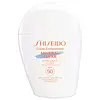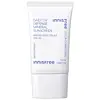What's inside
What's inside
 Key Ingredients
Key Ingredients

 Benefits
Benefits

 Concerns
Concerns

 Ingredients Side-by-side
Ingredients Side-by-side

Titanium Dioxide 4.5%
Cosmetic ColorantZinc Oxide 17.2%
Cosmetic ColorantDimethicone
EmollientWater
Skin ConditioningDiisopropyl Sebacate
EmollientDiphenylsiloxy Phenyl Trimethicone
Skin ConditioningDipropylene Glycol
HumectantGlycerin
HumectantSorbitan Sesquiisostearate
EmulsifyingPolyhydroxystearic Acid
EmulsifyingLauryl PEG-9 Polydimethylsiloxyethyl Dimethicone
Skin ConditioningSilica
AbrasiveAminoethanesulfinic Acid
AntioxidantThiotaurine
AntioxidantScutellaria Baicalensis Root Extract
AstringentPaeonia Albiflora Root Extract
Skin ConditioningSodium Hyaluronate
HumectantDipotassium Glycyrrhizate
HumectantGinkgo Biloba Leaf Extract
Skin ConditioningPEG/PPG-14/7 Dimethyl Ether
Skin ConditioningOnonis Spinosa Root Extract
AntiseborrhoeicCamellia Japonica Flower Extract
EmollientGarcinia Mangostana Bark Extract
Skin ConditioningTrehalose
HumectantSpirulina Platensis Extract
Skin ProtectingSoluble Collagen
HumectantAluminum Hydroxide
EmollientTriethoxycaprylylsilane
Stearic Acid
CleansingDisteardimonium Hectorite
StabilisingButylene Glycol
HumectantTrisodium EDTA
Isostearic Acid
CleansingSodium Citrate
BufferingCitric Acid
BufferingSodium Metabisulfite
AntioxidantPrunus Yedoensis Leaf Extract
Skin ConditioningSyzygium Jambos Leaf Extract
Skin ConditioningTocopherol
AntioxidantMica
Cosmetic ColorantDisodium Phosphate
BufferingRiboflavin
Cosmetic ColorantErgothioneine
AntioxidantSodium Phosphate
BufferingPhenoxyethanol
PreservativeBenzoic Acid
MaskingTitanium Dioxide 4.5%, Zinc Oxide 17.2%, Dimethicone, Water, Diisopropyl Sebacate, Diphenylsiloxy Phenyl Trimethicone, Dipropylene Glycol, Glycerin, Sorbitan Sesquiisostearate, Polyhydroxystearic Acid, Lauryl PEG-9 Polydimethylsiloxyethyl Dimethicone, Silica, Aminoethanesulfinic Acid, Thiotaurine, Scutellaria Baicalensis Root Extract, Paeonia Albiflora Root Extract, Sodium Hyaluronate, Dipotassium Glycyrrhizate, Ginkgo Biloba Leaf Extract, PEG/PPG-14/7 Dimethyl Ether, Ononis Spinosa Root Extract, Camellia Japonica Flower Extract, Garcinia Mangostana Bark Extract, Trehalose, Spirulina Platensis Extract, Soluble Collagen, Aluminum Hydroxide, Triethoxycaprylylsilane, Stearic Acid, Disteardimonium Hectorite, Butylene Glycol, Trisodium EDTA, Isostearic Acid, Sodium Citrate, Citric Acid, Sodium Metabisulfite, Prunus Yedoensis Leaf Extract, Syzygium Jambos Leaf Extract, Tocopherol, Mica, Disodium Phosphate, Riboflavin, Ergothioneine, Sodium Phosphate, Phenoxyethanol, Benzoic Acid
Zinc Oxide 17%
Cosmetic ColorantWater
Skin ConditioningPropylheptyl Caprylate
EmollientButyloctyl Salicylate
Skin ConditioningPropanediol
SolventCaprylyl Methicone
Skin ConditioningDisiloxane
Skin ConditioningPolyglyceryl-3 Polydimethylsiloxyethyl Dimethicone
Skin ConditioningPolymethylsilsesquioxane
Polyglyceryl-2 Dipolyhydroxystearate
Skin ConditioningDisteardimonium Hectorite
StabilisingMagnesium Sulfate
Triethoxycaprylylsilane
1,2-Hexanediol
Skin ConditioningSilica
AbrasiveLauryl Polyglyceryl-3 Polydimethylsiloxyethyl Dimethicone
Skin ConditioningSynthetic Fluorphlogopite
Dicaprylyl Carbonate
EmollientCaprylyl Glycol
EmollientGlyceryl Caprylate
EmollientCI 77288
Cosmetic ColorantMica
Cosmetic ColorantEthylhexylglycerin
Skin ConditioningSodium Hyaluronate
HumectantTocopherol
AntioxidantSqualane
EmollientCeramide NP
Skin ConditioningNiacinamide
SmoothingHydrolyzed Sodium Hyaluronate
Skin ConditioningPanthenol
Skin ConditioningButylene Glycol
HumectantCentella Asiatica Extract
CleansingCentella Asiatica Leaf Extract
Skin ConditioningSaccharomyces Ferment
Skin ConditioningCentella Asiatica Root Extract
Skin ConditioningHydroxypropyltrimonium Hyaluronate
Asiaticoside
AntioxidantMadecassoside
AntioxidantHydrolyzed Hyaluronic Acid
HumectantSodium Acetylated Hyaluronate
HumectantHyaluronic Acid
HumectantSodium Hyaluronate Crosspolymer
HumectantPotassium Hyaluronate
Skin ConditioningAsiatic Acid
Skin ConditioningMadecassic Acid
Skin ConditioningZinc Oxide 17%, Water, Propylheptyl Caprylate, Butyloctyl Salicylate, Propanediol, Caprylyl Methicone, Disiloxane, Polyglyceryl-3 Polydimethylsiloxyethyl Dimethicone, Polymethylsilsesquioxane, Polyglyceryl-2 Dipolyhydroxystearate, Disteardimonium Hectorite, Magnesium Sulfate, Triethoxycaprylylsilane, 1,2-Hexanediol, Silica, Lauryl Polyglyceryl-3 Polydimethylsiloxyethyl Dimethicone, Synthetic Fluorphlogopite, Dicaprylyl Carbonate, Caprylyl Glycol, Glyceryl Caprylate, CI 77288, Mica, Ethylhexylglycerin, Sodium Hyaluronate, Tocopherol, Squalane, Ceramide NP, Niacinamide, Hydrolyzed Sodium Hyaluronate, Panthenol, Butylene Glycol, Centella Asiatica Extract, Centella Asiatica Leaf Extract, Saccharomyces Ferment, Centella Asiatica Root Extract, Hydroxypropyltrimonium Hyaluronate, Asiaticoside, Madecassoside, Hydrolyzed Hyaluronic Acid, Sodium Acetylated Hyaluronate, Hyaluronic Acid, Sodium Hyaluronate Crosspolymer, Potassium Hyaluronate, Asiatic Acid, Madecassic Acid
 Reviews
Reviews

Ingredients Explained
These ingredients are found in both products.
Ingredients higher up in an ingredient list are typically present in a larger amount.
Butylene Glycol (or BG) is used within cosmetic products for a few different reasons:
Overall, Butylene Glycol is a safe and well-rounded ingredient that works well with other ingredients.
Though this ingredient works well with most skin types, some people with sensitive skin may experience a reaction such as allergic rashes, closed comedones, or itchiness.
Learn more about Butylene GlycolDisteardimonium Hectorite comes from the clay mineral named hectorite. It is used to add thickness to a product.
It can also help stabilize a product by helping to disperse other ingredients.
Hectorite is a rare, white clay mineral.
Learn more about Disteardimonium HectoriteMica is a naturally occurring mineral used to add shimmer and color in cosmetics. It can also help improve the texture of a product or give it an opaque, white/silver color.
Serecite is the name for very fine but ragged grains of mica.
This ingredient is often coated with metal oxides like titanium dioxide. Trace amounts of heavy metals may be found in mica, but these metals are not harmful in our personal products.
Mica has been used since prehistoric times throughout the world. Ancient Egyptian, Indian, Greek, Roman, Aztec, and Chinese civilizations have used mica.
Learn more about MicaSilica, also known as silicon dioxide, is a naturally occurring mineral. It is used as a fine, spherical, and porous powder in cosmetics.
Though it has exfoliant properties, the function of silica varies depending on the product.
The unique structure of silica enhances the spreadability and adds smoothness, making it a great texture enhancer.
It is also used as an active carrier, emulsifier, and mattifier due to its ability to absorb excess oil.
In some products, tiny microneedles called spicules are made from silica or hydrolyzed sponge. When you rub them in, they lightly polish away dead skin layers and enhance the penetration of active ingredients.
Learn more about SilicaSodium Hyaluronate is hyaluronic acid's salt form. It is commonly derived from the sodium salt of hyaluronic acid.
Like hyaluronic acid, it is great at holding water and acts as a humectant. This makes it a great skin hydrating ingredient.
Sodium Hyaluronate is naturally occurring in our bodies and is mostly found in eye fluid and joints.
These are some other common types of Hyaluronic Acid:
Learn more about Sodium HyaluronateTocopherol (also known as Vitamin E) is a common antioxidant used to help protect the skin from free-radicals and strengthen the skin barrier. It's also fat soluble - this means our skin is great at absorbing it.
Vitamin E also helps keep your natural skin lipids healthy. Your lipid skin barrier naturally consists of lipids, ceramides, and fatty acids. Vitamin E offers extra protection for your skin’s lipid barrier, keeping your skin healthy and nourished.
Another benefit is a bit of UV protection. Vitamin E helps reduce the damage caused by UVB rays. (It should not replace your sunscreen). Combining it with Vitamin C can decrease sunburned cells and hyperpigmentation after UV exposure.
You might have noticed Vitamin E + C often paired together. This is because it is great at stabilizing Vitamin C. Using the two together helps increase the effectiveness of both ingredients.
There are often claims that Vitamin E can reduce/prevent scarring, but these claims haven't been confirmed by scientific research.
Learn more about TocopherolTriethoxycaprylylsilane is a silicone used to bind and stabilize ingredients.
As an emulsifier, it helps prevent ingredients from separating. This can help elongate the shelf life of products.
Triethoxycaprylylsilane is often used to coat mineral sunscreens ingredients to help give a better feel. It also helps reduce oxidative stress in sunscreens.
Learn more about TriethoxycaprylylsilaneWater. It's the most common cosmetic ingredient of all. You'll usually see it at the top of ingredient lists, meaning that it makes up the largest part of the product.
So why is it so popular? Water most often acts as a solvent - this means that it helps dissolve other ingredients into the formulation.
You'll also recognize water as that liquid we all need to stay alive. If you see this, drink a glass of water. Stay hydrated!
Learn more about WaterZinc Oxide is a mineral broad-spectrum UV filter; it is the broadest UVA and UVB reflector approved by the FDA. It also has skin protectant and skin soothing properties.
Zinc oxide is one of the most effective broad-spectrum UV filters. It protects against UVB, UVAII, and UVAI. In comparison to its counterpart titanium dioxide, zinc oxide provides uniform and extended UVA protection.
Another great benefit? This ingredient is highly photostable so it won't degrade easily under sunlight.
A common myth is that mineral UV filters are widely believed to primarily reflect UV light.
However, modern research shows titanium dioxide absorbs UV radiation like chemical filters (~95% absorption & 5% reflection).
Zinc oxide has great skin soothing properties so you'll likely find this in sunscreens formulated for sensitive skin or babies/children. It is unlikely to cause "eye sting" like other sunscreen ingredients.
Regulatory agencies consider zinc oxide to be non-toxic and safe. It has also been shown to not penetrate the skin.
Unfortunately, this ingredient does leave a visible white cast. This is why mineral sunscreens are often less cosmetically elegant than chemical or hybrid ones.
In cosmetics, zinc oxide can be found in both non-nano and nano-sized forms. The nano version is used to reduce white cast and improve the texture of sunscreen formulas.
There are ongoing concerns surrounding nano-zinc oxide's impact on marine ecosystems and whether it can be absorbed into skin.
Regarding marine ecosystems and coral reefs, there is no conclusive evidence that any form of zinc oxide (or any other sunscreen ingredients) will cause harm. The science is still developing but many consumers are keeping a close eye on this issue.
Please note, many destinations have reef-safety sunscreen rules. For instance, the U.S. Virgin Islands advises all visitors to use non-nano mineral sunscreens.
There has also been some stir about whether micronized or nano zinc oxide has potential photoxicity and absorption through the skin/lungs.
An in-vitro (done in a test tube or petri dish) study demonstrated micronized zinc oxide to have potential phototoxicity. There's no need to fret; the EU Commission's Scientific Committee on Consumer Safety has stated, "The relevance of these findings needs to be clarified by appropriate investigations in vivo." Or in other words, further studies done on living organisms are needed to prove this.
Current research shows zinc oxide nanoparticles do not penetrate intact or sunburned skin. They either remain on the surface or in the outermost layer of dead skin (stratum corneum).
Zinc oxide is one of only two classified mineral UV filters with titanium dioxide being the other one.
Fun fact: Zinc has been used throughout history as an ingredient in paint and medicine. An Indian text from 500BC is believed to list zinc oxide as a salve for open wound. The Ancient Greek physician Dioscorides has also mentioned the use of zinc as an ointment in 1AD.
Learn more about Zinc Oxide